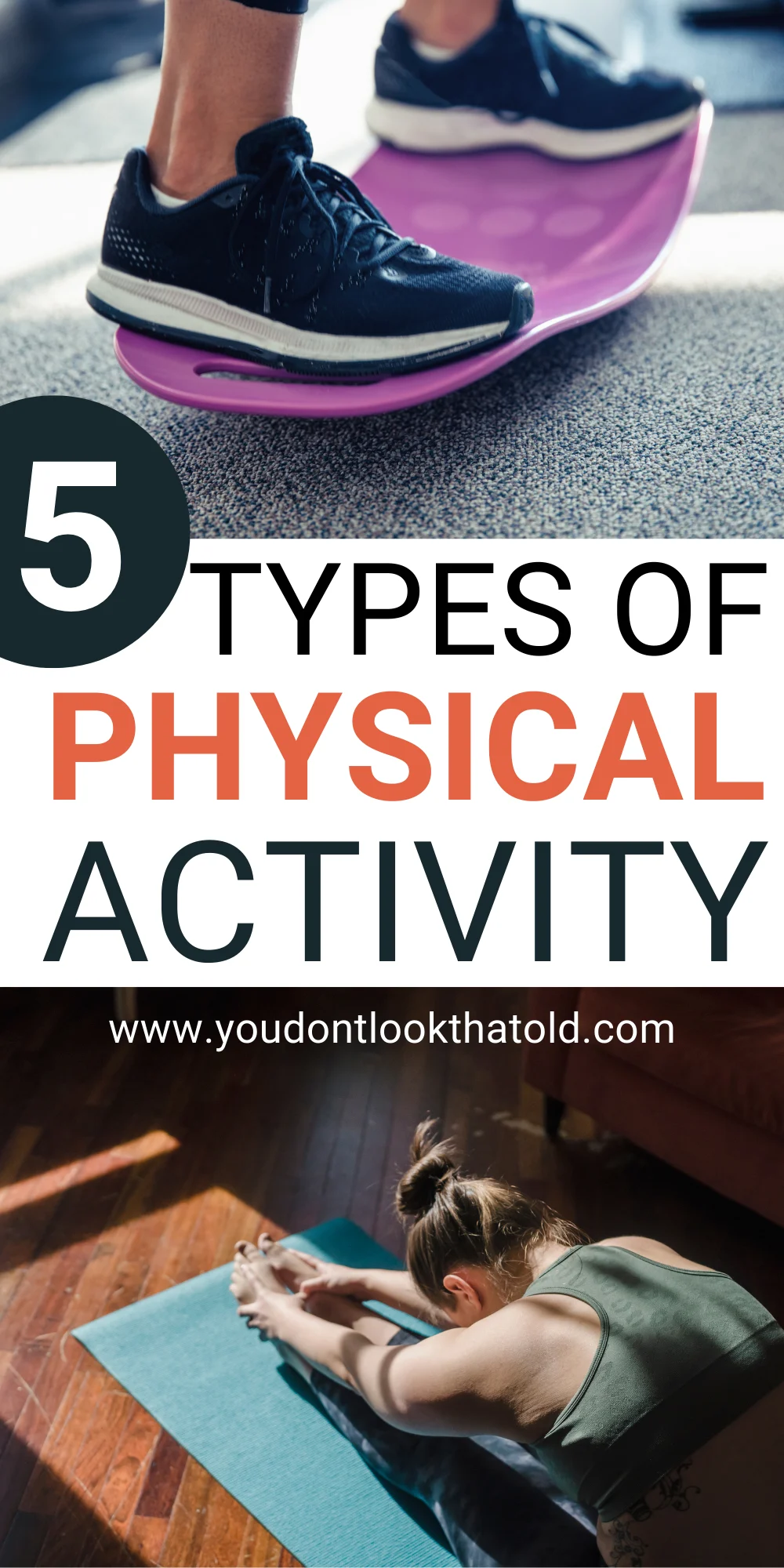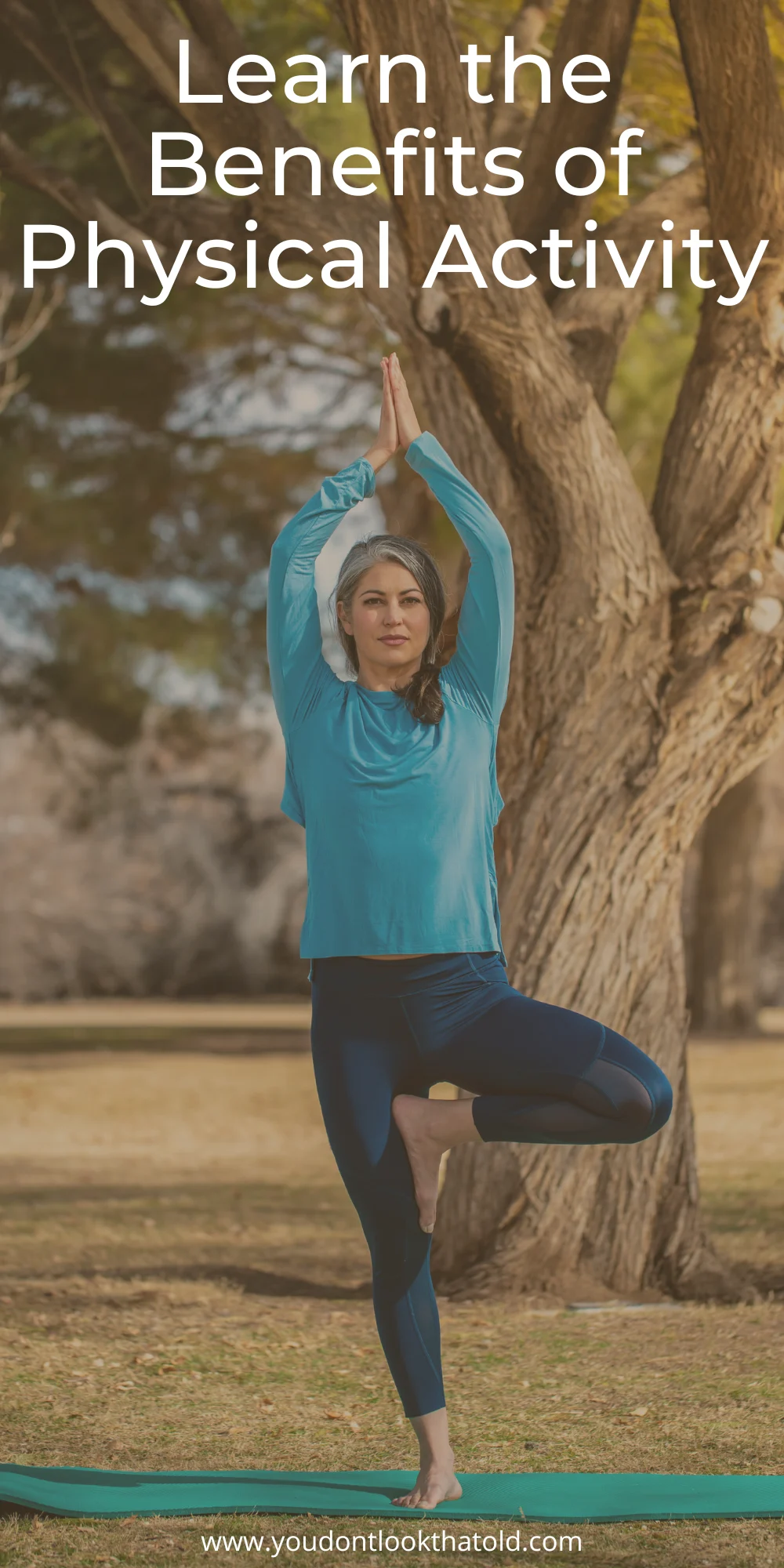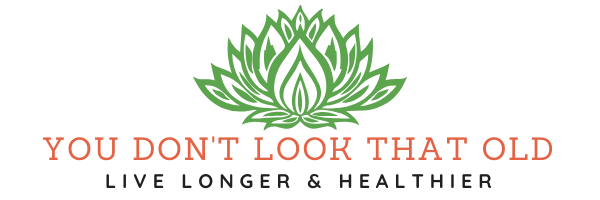Have you ever stopped and wondered which physical activities are most beneficial for you to stay fit and healthy? This blog post will explore the five main types & benefits of physical activity that should be part of your daily routine.
Physical activities involve aerobic exercise, balance exercise, muscle strength training, bone strengthening, and flexibility training —all designed to help you feel strong and energized!
We’ll also talk about the benefits to your physical health & mental health. These activities can improve posture and coordination while decreasing the risk of injury and alleviating feelings of depression and stress.
With all the options available, it can be intimidating to decide what’s best for your body; hopefully, with this information, you will feel better equipped to understand how different types of fitness affect your overall health. Let’s get started!

What is Physical Activity?
The definition of physical activity is broad: any physical movement produced by skeletal muscles that require energy expenditure, making it an essential part of a healthy lifestyle. It enhances endurance and strength, and countless physical, mental, and emotional benefits are associated with regular movement.
Why Physical Activity Is Important
Physical activity is essential to a healthy lifestyle and has many benefits. Regular movement can improve physical and mental health, help protect against a range of chronic diseases, and even increase life expectancy. It helps to reduce the risk of obesity, heart disease, diabetes, and some types of cancer while building stronger muscles and bones.
It can also reduce stress, improve sleep quality and help to balance mood by releasing feel-good hormones in our brains. More importantly, physical activity can boost concentration levels so that we can stay focused longer on tasks that require more cognitive thinking, such as school or work.

It’s important to note that physical activity does not have to be strenuous to be beneficial; even light physical activities like walking or gardening can significantly contribute to physical well-being. Ultimately, physical activity should fit into your lifestyle – if you prioritize it and make it fun, it will become an integral part of your life.
How Much Physical Activity Do Adults Need?
Adults need physical activity to lead a healthy and balanced lifestyle. According to the physical activity guidelines set forth by the U.S. Department of Health and Human Services, adults should aim for at least 150 minutes of moderate physical activity per week or 75 minutes of vigorous physical activity. However, moving your body is beneficial in any amount
5 Main Types of Physical Activity
- Aerobic
- Balance
- Muscle Strengthening
- Bone Strengthening
- Flexibility

#1 Physical Activity – Aerobic Exercise
Aerobic exercise centers on large muscle movement that increases heart rate and breathing, improving circulation and boosting energy. It provides physical fitness benefits such as improved cardiovascular health, better muscle tone, and weight control.
Bottom line: your heart will beat faster, and your breaths will be more laborious during aerobic exercise. Both of these results strengthen your heart and lungs, which helps these two organs to work better together.
Examples of Aerobic Exercise
There are different levels of intensity depending on which aerobic exercise. For example, the lowest intensity level includes everyday activities you likely don’t realize benefit your health. Examples might be going up and down stairs, grocery shopping with a cart, gardening, or vacuuming.
The harder you work, the greater the intensity and the better for your physical health. More intense activities include running, jumping rope, swimming, hiking, biking, team sports, rowing, or dancing. Such physical activities provide benefits by increasing the circulatory performance of the body’s vital organs, especially the heart and lungs.
Benefits of Aerobic Exercise
Aerobic exercise also potentially increases self-esteem, reduces stress levels, and alleviates depression symptoms. Additionally, it helps maintain healthy bones, muscles, and joints by decreasing their breakdown process while providing improved flexibility during physical movement in everyday tasks.
#2 Physical Activity- Balance
Balance exercises can be a great way to get moving and build strength. According to the National Heart, Lung, and Blood Insitute, “balance activities can improve your ability to resist forces that can make you fall while stationary or moving.” Balance exercises strengthen muscles of the back, abdomen, and legs.
Benefits of Balance Exercise
Prioritizing balance exercises helps to improve coordination, posture, physical fitness, and body stability. Such exercises focus on strengthening the core muscles between the hips and shoulders. It’s not just physical benefits; balance exercises help relieve stress, boost self-confidence and facilitate healthy aging.
Examples of Balance Exercise
Balance activities include forward stepping, walking backward, squats, walking heel-to-toe, using a balance board, or even yoga postures on the floor or using a yoga ball. Working your way up to more challenging exercises like standing on one leg is encouraged!
As long as it’s done safely and with proper form, balance exercises are an enjoyable activity that can help you become fitter — both mind & body
Walking backward, standing on one leg, walking heel-to-toe, practicing standing from a sitting position, or using a wobble board are examples of balance activities.

#3 Physical Activity – Muscle Strengthening
Muscle strengthening exercises are physical activities that help to increase one’s physical strength by targeting specific muscles. Unlike aerobic exercise, which focuses on cardiovascular endurance, muscle strengthening exercises are designed to target specific muscle groups, which can be done in various ways.
Benefits of Muscle Strengthening Exercise
Strengthening them has numerous benefits, such as increasing physical strength, stabilizing the body’s core, and improving your existing physical capabilities. Ultimately these forms of physical activity have seen many benefits, including improved physical function and body composition, which may contribute to a lower risk of chronic diseases over time.
Examples of Muscle Strengthening Exercise
Pilates, weight training, and yoga are all types of physical activity that help to build and maintain muscle strength. Depending on the level of physical fitness and desired outcome, the type and number of repetitions for each exercise and intensity will vary greatly.
#4 Physical Activity – Bone Strengthening
Bone-strengthening activities require your feet, legs, or arms to support your body’s weight, and your muscles push against your bones which helps make bones strong. Incorporating physical activity into your routine is essential for optimal bone health. Bone strengthening exercises are crucial to maintaining strong bones, as physical activities help to slow down and even reverse bone loss caused by aging.
Benefits of Bone Strengthening Exercise
Bone strengthening exercises can help improve your balance, oxygen intake, and coordination. These exercises help strengthen bones and reduce the risk of fractures and osteoporosis by increasing the strength and density of the bones. These activities are beneficial for improving physical health and mental health by reducing stress levels and improving mood.
Examples of Bone Strengthening Exercise
Physical activities include walking, jumping rope or jogging, weight-lifting, Tai Chi, and Yoga, which are great examples of bone-strengthening exercises.

#5 Physical Activity – Flexibility Exercise
Flexibility exercise is an important physical activity to incorporate into anyone’s lifestyle. It is beneficial for achieving a better physical range of motion in joints, muscles, and other body parts.
Benefits of Flexibility Exercises
Stretching helps improve physical performance and reduce the risk of physical injury during physical activities like running or weight lifting. In addition, stretching helps improve your flexibility and ability to move your joints fully.
Flexibility also promotes recovery from ailments like muscle tension and joint stiffness, which often cause discomfort throughout the day. Adding a consistent flexibility exercise routine to one’s fitness regimen helps ensure healthy muscles and joints.
Example of Flexibility Activities
Touching your toes, doing side stretches, and doing yoga exercises are examples of stretching.
The Importance of Physical Activity
So there you have it! An overview of the different types of physical activity and the benefits of each one. Now that you know a little bit more about the types of physical exercise and their benefits, which one will you incorporate into your daily routine today?
Remember, any movement is better than none at all. Adding even a small amount of exercise can positively affect your overall health. So even if you can only fit in a 10-minute walk around the block, it’s still worth doing.

